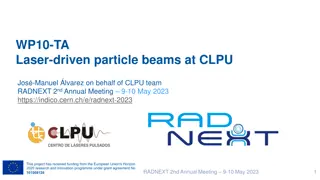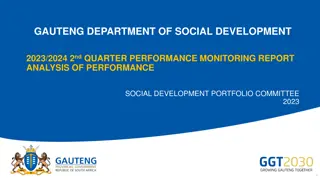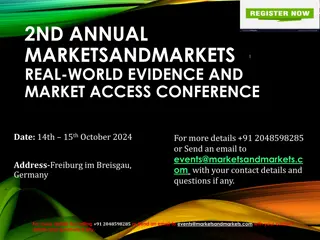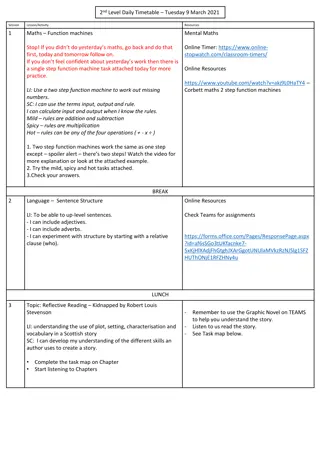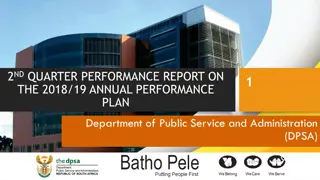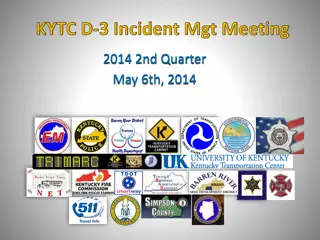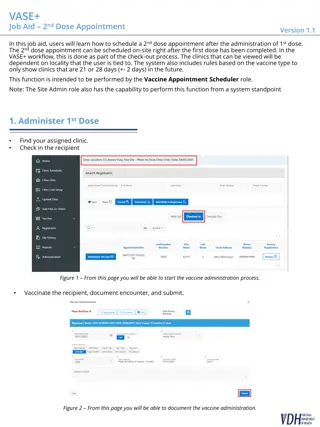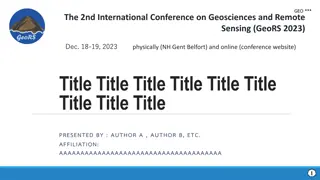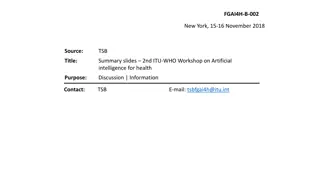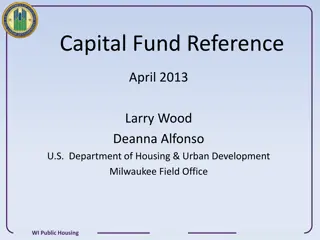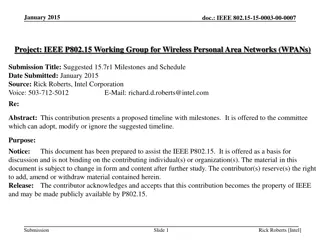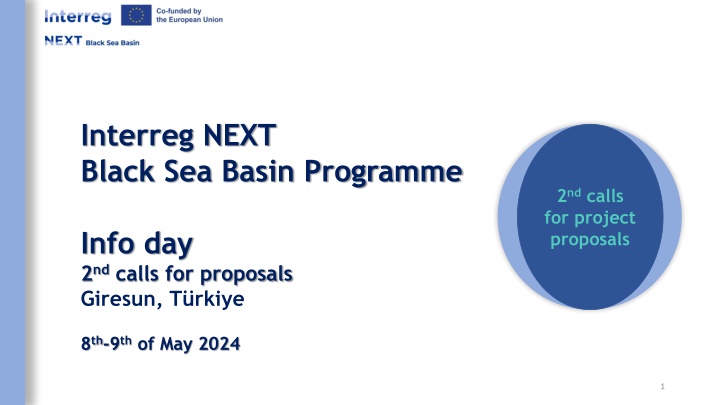
Interreg NEXT Black Sea Basin Programme - Calls for Project Proposals
The Interreg NEXT Black Sea Basin Programme is organizing the 2nd calls for project proposals info day in Giresun, Turkey on 8th-9th of May 2024. The event focuses on the submission of application forms through the Joint Electronic Monitoring System (JeMS), emphasizing the creation of manuals, methods, briefs, documentaries, and multimedia materials based on past experiences. It highlights the importance of registering on EC Participant Register prior to submission and undergoing pre-submission checks by JeMS. The programme priorities include enhancing research and innovation capacities, promoting climate change adaptation, and fostering cooperation and governance for a more competitive and greener Europe.
Download Presentation

Please find below an Image/Link to download the presentation.
The content on the website is provided AS IS for your information and personal use only. It may not be sold, licensed, or shared on other websites without obtaining consent from the author. If you encounter any issues during the download, it is possible that the publisher has removed the file from their server.
You are allowed to download the files provided on this website for personal or commercial use, subject to the condition that they are used lawfully. All files are the property of their respective owners.
The content on the website is provided AS IS for your information and personal use only. It may not be sold, licensed, or shared on other websites without obtaining consent from the author.
E N D
Presentation Transcript
Interreg NEXT Black Sea Basin Programme 2nd calls for project proposals Info day 2nd calls for proposals Giresun, T rkiye 8th-9th of May 2024 1 1
Submission of Application Form Joint Electronic Monitoring System (JeMS) VISIBILITY Creation of manuals, methods, briefs, documentaries and multimedia material based on JOP BSB 2014-2020 experiences Applications submitted on-line, only by the Lead Partner Creation of manuals, methods, briefs, documentaries and multimedia material based on JOP BSB 2014-2020 experiences Other users (consultants or Partners) allowed to fill in sections of the Application they can read or add/modify data in the AF, only after the Lead Partner gives the necessary permissions REGISTER ON EC PARTICIPANT REGISTER PRIOR TO SUBMISSION OF THE APPLICATION! Pre-submission checks automatically made by JeMS - verifies that all sections are filled in with text, not the quality of information! What s new? JeMS does not allow submission of Application unless all fields are filled in. Take sufficient time for verifications! 2
Programme Priorities and Logic Specific Objective Policy Objective 1 Priority 1 Fields of actions 1. Developing and enhancing research and innovation capacities Blue and Smart region A more competitive and smarter Europe R E G U L A R Specific Objectives Policy Objective 2 Priority 2 4. Promoting climate change adaptation and prevention 7. Enhancing preservation biodiversity infrastructure S M A L L S C A L E disaster risk Clean and Green region Fields of actions A greener Europe protection of and and nature, green Priority 3 Interreg Specific Objective 1 Specific Objective Competent and Resilient Region Build up mutual trust in particular by encouraging people-to-people actions Field of action Better cooperation governance
Intervention logic PROJECT PROGRAMME Transnational challenges and needs of Programme area Transnational challenges and needs addressed by the project C h a n g e Programme specific objectives Project objectives Fields of actions Activities Programme Output indicators Project Outputs Programme Result indicators Project Results
Programme logic Results Outputs Project logic Activity N Activity 1 Activity 2 Work package CHANGE CHALLENGE Specific objective Overall objective
Priority 1 Priority 2 Priority 3 Programme indicators BLUE AND SMART EUROPE CLEAN AND GREEN REGION COMPETENT AND RESILIENT REGION SO3 Mutual trust INDICATOR SO1 - Research and innovation SO4 Climate change SO7 Preservation of nature RCO07 Research organizations participating in joint research RCO81 Participations in joint actions across borders RCO87 Organisations cooperating across borders OUTPUT RCO84 Pilot actions developed jointly and implemented in projects RCO115 Public events across borders jointly organised RCO116 Jointly developed solutions RCR84 Organisations cooperating across borders after project completion RCR104 Solutions taken up or up-scaled by organisations RESULT
Organizations cooperating across borders after project completion (RCR84) Organisations cooperating across borders (RCO87) Definition: counts the organisations cooperating formally in supported projects Criteria: organisations counted in this indicator are the legal entities as mentioned in the application Example: project partners = 4 target value of RCO87 = 4 This indicator is compulsory for all projects
Organizations cooperating across borders after project completion (RCR84) Research organisations participating in joint research projects (RCO07) Definition: counts the number of supported research organisations that cooperate in joint research projects. Criteria (cumulative): - at least one partner be a research organisation, and - actively participate in the implementation of a joint research project. Examples: universities or research institutes, technology transfer agencies Only for SO1 Complements RCO87 (same organization may be counted both under RCO07 and RCO87)
Organizations cooperating across borders after project completion (RCR84) Public events across borders jointly organized (RCO115) Definition: countsthe number of events across borders jointly organized by the partners. Criteria (cumulative): - be advertised to the general public, and - be jointly organised by at least 2 partners, and - involves stakeholders outside the partnership from at least 2 countries Examples: trainings, workshops and seminars organized in the framework of the project, launching and final Conference of the project - the participation of the project staff in public events Does not count: - the number of participations in public events
Organizations cooperating across borders after project completion (RCR84) Participations in joint actions across borders (RCO81) Definition: counts the number of participations in joint actions across borders implemented in the supported projects. Criteria (cumulative): - joint actions (also on line, if justified) - organisations from at least 2countries, and - participation of persons outside the partnership. Example: number of participants from one participating country to a study visit in another participating country Only for SO3 Does not count: - participations in public events (as defined by RCO 115) - participations in internal project meetings of the partners
Research organisations participating in joint research projects (RCO07) Organizations cooperating across Participations in joint actions across borders (RCO81) borders after project completion Organisations cooperating across borders (RCO87) (RCR84) Public events across borders jointly organized (RCO115) Definition: counts the organizations cooperating across borders after the completion of the supported projects Criteria: - - refers to organisations involved in project implementation; have a cooperation agreement to continue cooperation after the end of the supported project (document to be signed and provided during contracting stage); cooperation could be on a similar or different topic. - Example: project partners = 6; if only 2 (or n) partners continue cooperation target value of RCR 84 = 2 (or n) Other project partners may sign the agreement at a later stage before the end of the project.
Solutions taken up or up-scaled by organisations (RCR104) Jointly developed solutions (RCO116) Definition: counts the number of jointly developed solutions from joint actions (including as a result of pilot actions) implemented by supported projects Solution = an action or a process of solving a problem Criteria (cumulative): - be jointly developed (draft and design) by project partners fromat least 2 countries, and - be developed during project implementation, and - include indications of the actions needed for it to be taken up or to be up-scaled. Examples: jointly developed platform, IT tool, data base, data collection method, etc. 1 solution developed (RCO 116) 1 solution tested (RCO 84) 1/0 solution further implemented (RCR 104)
Solutions taken up or up-scaled by organisations (RCR104) Pilot actions developed jointly and implemented in projects (RCO84) Definition: counts the pilot actions developed jointly and implemented by a project; Pilot action = a practical implementation of newly developed solutions Criteria (cumulative): - needs to be developed AND implemented within the project, and - implementation should be finalised by the end of the project, and - it implies the involvement of organizations from at least 2 countries. Examples: - - a small scale investment to test the effectiveness of a solution; a data collection/algorithm tested or piloted in a relevant organisation by the end of the project; an existing method applied to demonstrate its applicability to a certain sector/territory. -
Pilot actions developed jointly and implemented in projects (RCO84) Solutions taken up or up-scaled by organisations (RCR104) Jointly developed solutions (RCO116) Definition: counts the number of solutions and/or pilot actions, other than legal or administrative solutions, that are developed by supported projects AND are taken up or up- scaled during the implementation of the project or within one year after project completion. Criteria: - organisations adopting the solutions developed by the project may or may not be a participant in the project; the uptake / up-scaling should be documented by the adopting organizations in strategies, action plans etc. - Examples: Jointly developed platform, IT tool, data base, data collection method, etc. 1 solution developed (RCO116) 1 solution tested (RCO84) 1/0 solution further implemented (RCR104) target value of RCR104 = n/0
Intervention Logic Main takeaways: RCO87 - compulsory for all projects; Make sure that project objectives, activities and outputs are logically linked to the targeted Programme specific objectives and field(s) of action; Demonstrate that project clearly contributes to the programme output and result indicator(s) - ! many outputs and results higher project score; Be realistic when defining the target values - ! high target values higher project score; Lead Partner coordination role in definition and quantification of realistic target values for project indicators.
Application form main parts in JEMS Part A - Project identification A1 Project identification A.2 Project summary A.3 Project budget overview A.4 Project outputs and result overview Part B Project partners B.0 Partners overview B.1 Project partner - Budget options Part C Project description B0 - administrative and eligibility assessment C.1 Project overall objective C.2 Project relevance and context C.3 Project partnership C.4 Project workplan - Specific objective Activities - Outputs C.5 Project results C.6 Time plan C.7 Project management and communication C.8 Long-term effects and durability Part D Project budget overview B1 & C - quality assessment
Payment arrangements and reporting Annex 9 of Application Packs -Grant Contract- New 1 - recovered by deducting 20% from the eligible value of the Interreg funds included in the next payment requests until the amount is cleared Advance payment maximum 30% Several interim payments linked and based on actual expenditure made and reported N Reports cover 4 months implementation period - time needed for preparation and submission to the controllers for expenditure verification - include technical and financial information 19
Budget structure regular projects 1. Staff up to 20% of the eligible direct costs other than staff costs 2. Office and administration (indirect) - up to7% of the eligible direct costs - Set in Jems the percentage based on your estimated needs the amount shall be automatically calculated in Jems - No justifying/supporting documents required, except for a document proving the existence of the Staff cost category Flat rate 3. Travel and Accommodation 4. External expertise and services 5. Equipment 6. Infrastructureand works Real costs - Justifying/supporting documents required - Certification by the controller required 20
Budget small-scale projects option 1 The eligible costs for small scale projects are based on: Staffcosts Real costs - Justifying/supporting documents required - Certification by the controller required Other costs calculated as 40% of eligible direct staff costs covering the budget categories: - Office and Administration - Travel and Accommodation - External expertise and services - Equipment Flat rate - NO justifying/supporting documents required - NO certification by the controller required, directly linked to the expenditures certified as eligible for Staff costs Automatically calculated in Jems 21
Budget small-scale projects option 2 Staff Travel and accomodation External expertise and services Equipment Real costs - Justifying/supporting documents required - Certification by the controller required Office and administration (indirect) - up to7% of the eligible direct costs - Set in Jems the percentage based on your estimated needs The amount will be aautomatically calculated in Jems by applying the percentage of up to 7%, as decided by each partner, to the total eligible direct costs of the respective partner - No justifying/supporting documents required Flat rate 22
Information about the calls More information about the calls and the Application Packs may be checked/downloaded at: https://blacksea-cbc.net/interreg-next-bsb-2021- 2027/calls-for-proposals/second-call-for-proposals Help Desk Any request for clarifications may be addressed until 14th of June 2024 to the Joint Secretariat at: office@bsb.adrse.ro Last date on which clarifications are issued by JS shall be 21st of June 2024 23
www.facebook.com/BlackSeaBasin/ Help desk: office@bsb.adrse.ro www.blacksea-cbc.net www.instagram.com/blackseabasincbc/ 24



